Introduction
In accordance with the previously outlined research design, the primary research provided first-hand information from the interviews and questionnaire given out. I used questionnaires to acquire information about the experience of owning a purebred pet from different pet owners.
Survey and Stakeholder Interviews
I conducted a survey on the pet owners using questionnaires in order to gain precise reflection on the experience of owning and caring for a purebred pet. The survey results were as follows based on the research group responses.
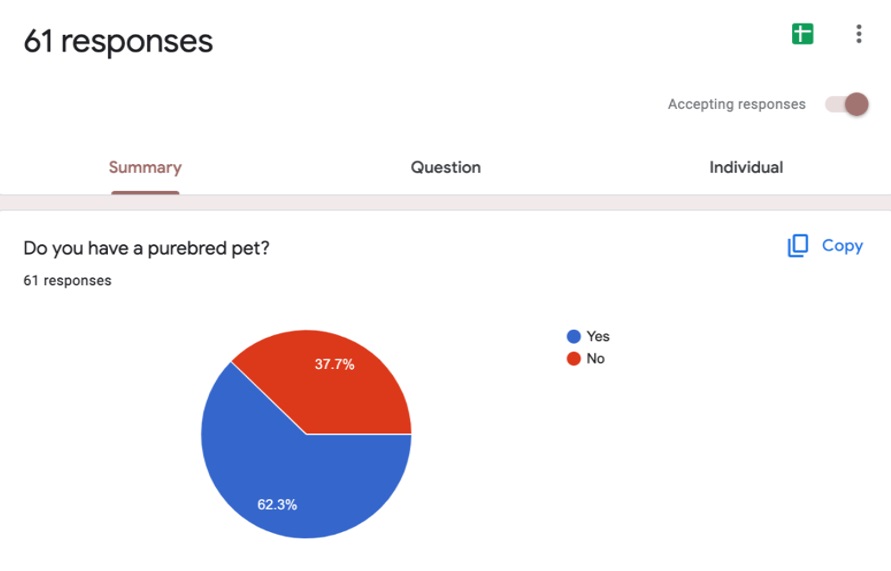
Out of the sixty-one responses, 62.3% of the research group owned a purebred pet. This shows how a large population of people who wish to own pets will choose to go for a purebred pet. The age for the pets varied from 0–10-year-old where majority of them were below two years.
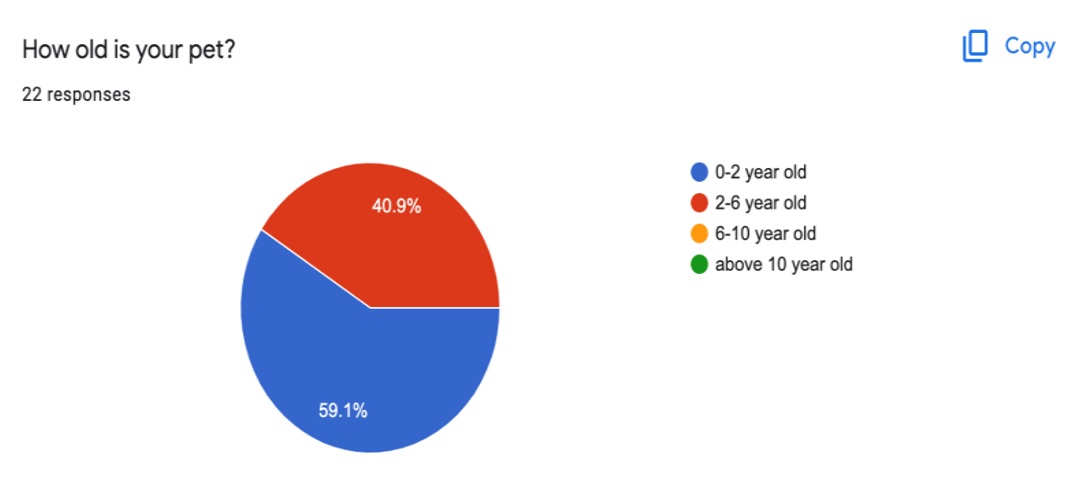
The questionnaire sorts out to find the type of breed the pet were and whether the pet owners knew the type of genetic disorder their pets were susceptible to. This part of the questionnaire was meant to derive information on how well individuals understand the purebred pets before determining the type of pet they want. It also provided insight on the pet owner understanding of the type of genetic diseases their pets are prone to contracting.
As illustrated below, the survey also shows how some of pet owners assume the factor of genetic related diseases. They perceive that these genetic related diseases are based on the health quality of the parent. This supports the need to create more awareness of the existence of the genetic related diseases among purebred pets. However, few entries proved that some of the pet owners understood the breed origin of their pets and the genetic diseases they are likely to contract. For example, one of the responses shows that a Golden retriever breed is susceptible to cancer disease. It is approximated that 56% of the Goldens die as a result of malignancy formation which is usually fast-growing and an aggressive form of cancer. Understanding the possibility of one’s pet contracting cancer disease will help the owner alert for early detention by working with a breeder who can screen cancer to minimize this genetic risk.
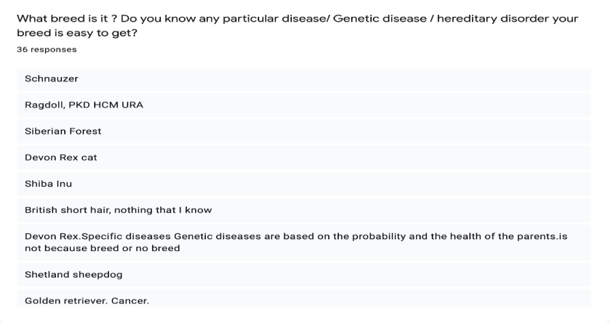

A survey was done the different sources that individuals acquire their pets from. A high percentage of 68.2% of the 22 responses showed that many individuals got their pets from rescue or shelter adoption centers. A huge number also acquired their pets from family or a hobby breeder who the pet owner knows. Choosing pets from a rescue center comes with the advantage of choosing from a pet from a great selection of animals. In addition, pets from a rescue center receive the best care since they are handled by experienced workers. They also receive vaccinations and provided a behavior training schedule.
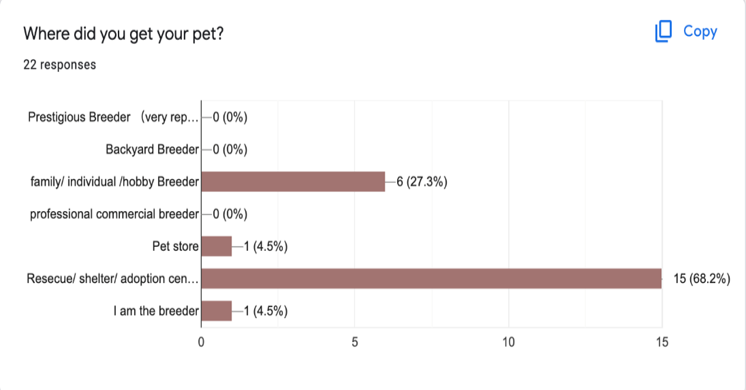
The research study group was asked on the pain points they experience while taking care of their pets to determine their knowledge on the health issues related to pets. A high number of individuals complained of expensive fee when consulting a veterinarian. Other pain points included difficulty in making appointments with the clinic veterinarian and ineffective communication with the veterinarian on their pet’s health status. However, few individuals reported that they had no idea of handling a sick pet and lacked the knowledge of where to get information related to their pet’s health status. This survey goes on to support the need for creating awareness of how to treat and handle pets that fall sick. One should not ignore any symptoms because late detection of diseases in pets means low chances of survival.
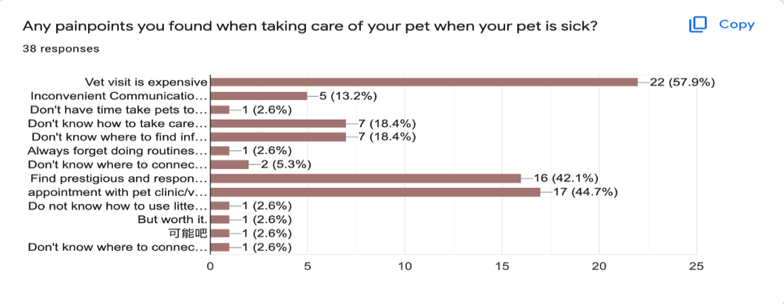
The questionnaire asked the respondents if they thought purebred pets had more health issues compared to animals that are not, this aimed at testing the individual’s awareness level about the purebred pets. Out of the 31 responses, 16.1% of the individuals thought that the purebred pets do not have more health issues. This survey shows that most of the purebred pet owners are not aware of the genetic diseases that the pets are vulnerable to. The respondents also had no idea of any pet owner whose pet was suffering from genetic disease. Therefore, this product will provide a connection area where one can find other pet owners who have shared their experiences of taking care of a sick pet.
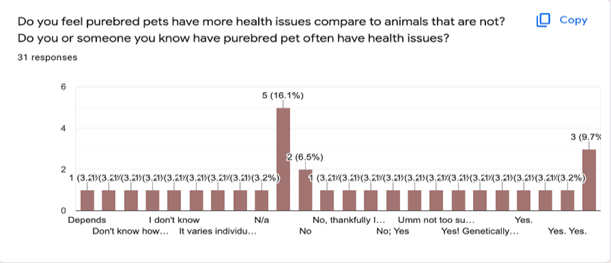
The research aimed also at finding out whether breeder is concerned on the well-being and progress of the breed they have created. Majority of the individuals claimed that the breeders follow up on the core vaccines needed by the pets and deworming on a regular period of time. Breeders also made appointments for the pets to conduct a health check which ensure the animals are checked on a regular basis. Pet owners, therefore, have to safeguard the health information of their pets to ensure follow ups are easy to be conducted by the clinic veterinarian.
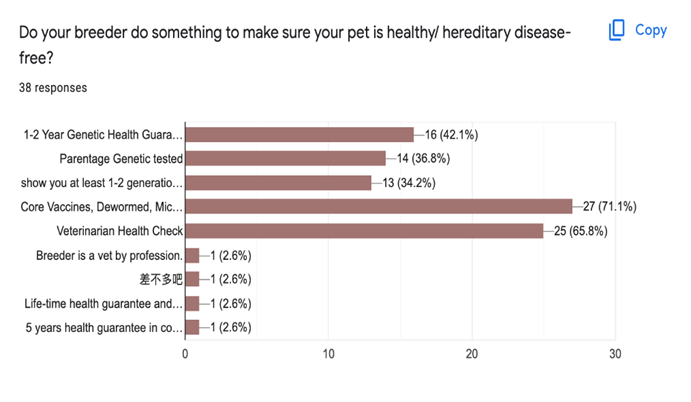
Huge number of individuals also agreed that their breeders provide a guarantee of their pet health condition and any genetic related disease. 52.6% of the respondent affirmed that the breeders are sure of the future health status of the purebred they produce. This means individuals have confidence while purchasing a purebred pet because the breeders provide guarantee of long life for the pets. However, there were complains of guarantee by a word of mouth no prove was provided for the individual acquiring the pet.

On the issue of clinic visitation, out of the 38 responses, 36.8% visited the clinic once or twice per year for a specific reason such as mild cough. However, a small number of 13.2% claimed that they never visited the clinic. When visiting the clinic for wellness or parasite control, majority of the individuals made a visitation to the clinic once or twice a year.
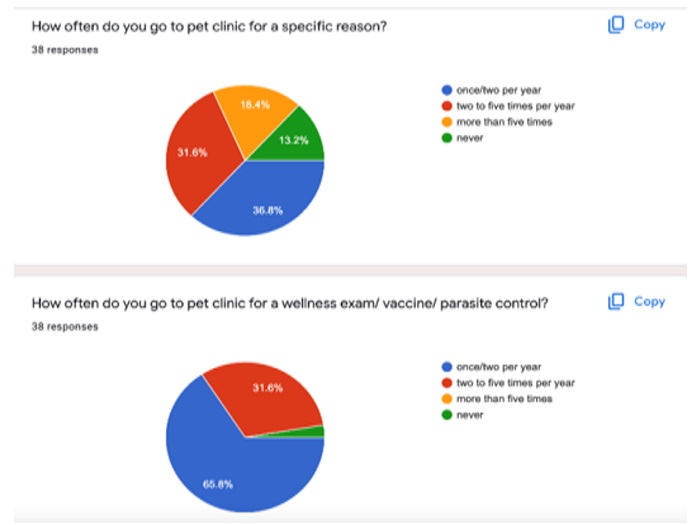
Majority of the individuals, choosing a purebred pet, chose it for the specific traits that are found in the breed. Some of them felt that purebred pets have a better personality compared to other animals. Showing off fancy pet and beauty appearance were additional factors some of the pet owners considered while choosing a purebred pet.
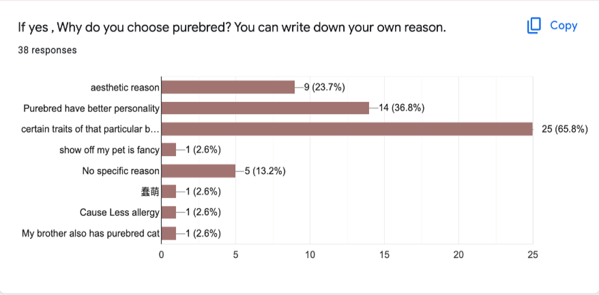
Individuals, who did not prefer purebred as pets, affirmed that they chose adopting these purebreds instead of purchasing them. This could be related to the fact that purebred is more vulnerable compared to the other animals. A large number gave cost factors has a hindrance and the fact that purebred animals are more vulnerable to health problems due to their genetic structure. As expected, a small number claimed they do not care about breed of the pet.
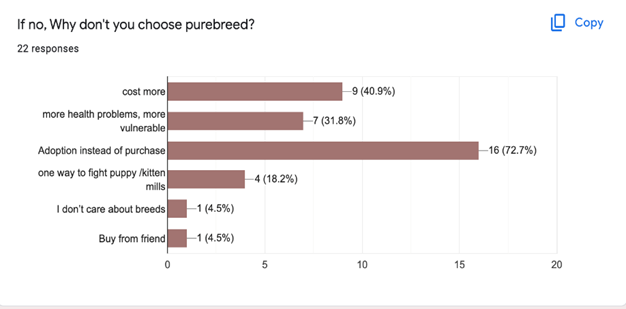
Diary Research
During the diary research, the participant chose to write down their daily activities in a diary. The diary study took place for a period of three weeks and information was analyzed and interpreted as follows. In the first week, the respondent gives the account of their cat after undergoing surgery. The pet faces the challenges of taking proper meals and experiencing pain from time to time. The experiences of the cats during the first week with medication taken are noted in the diary as indicated in the diagram below (see Fig. 12).
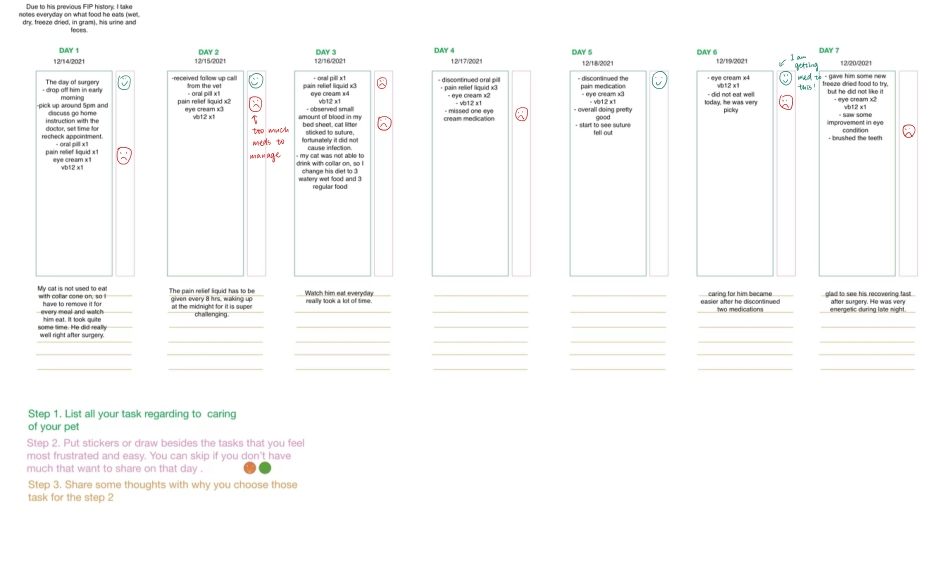
In the second week, the cat was fully recovered from the neuter surgery but had issues with appetite, under the application of eye cream for eye ulcers, three times a day.
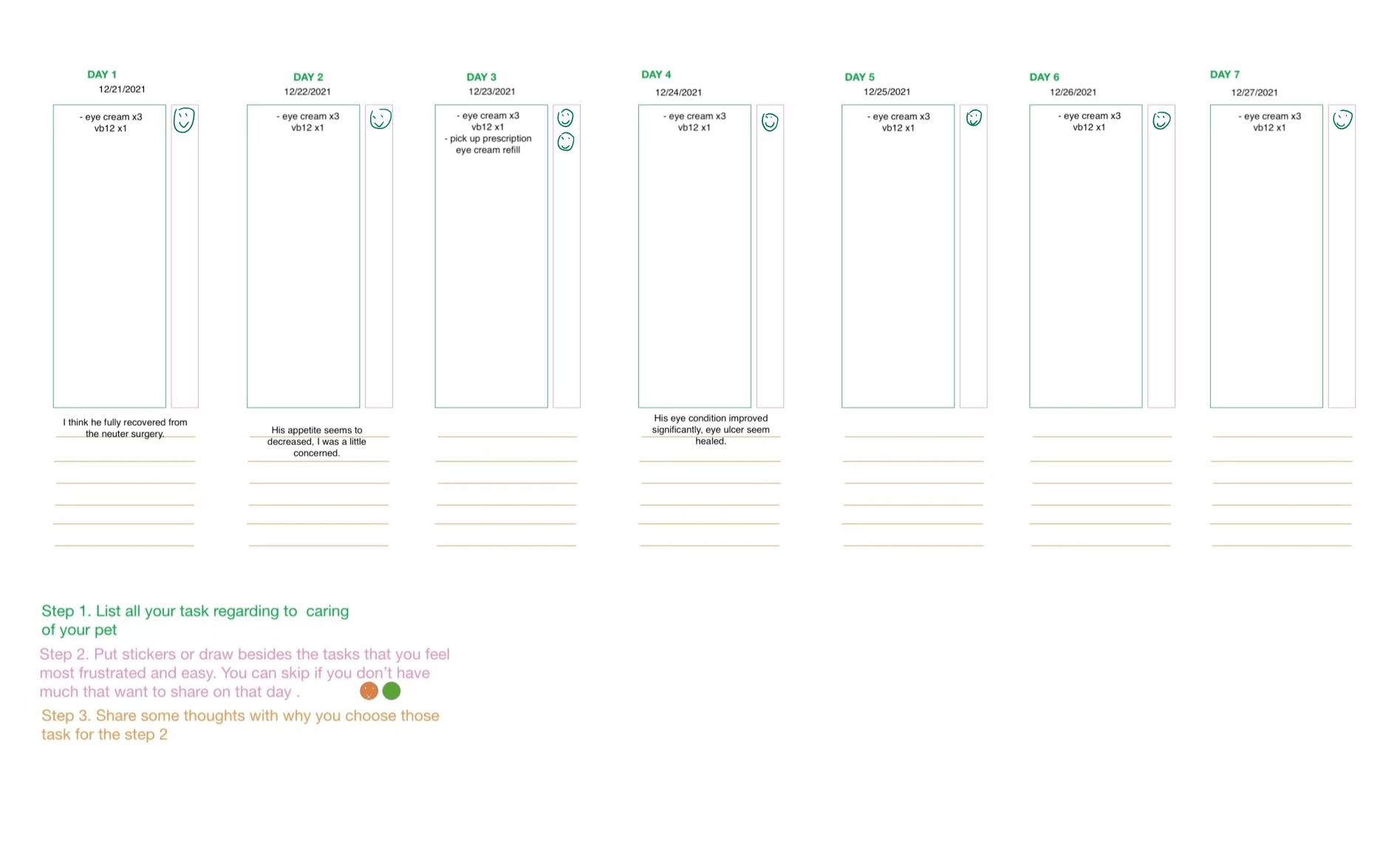
In the third week, the pet owner tried changing the type of food for the cat, but it did not improve the feeding habits. However, at the end of the third week, the cat had fully recovered, finished all the prescriptions, and appeared normal again.
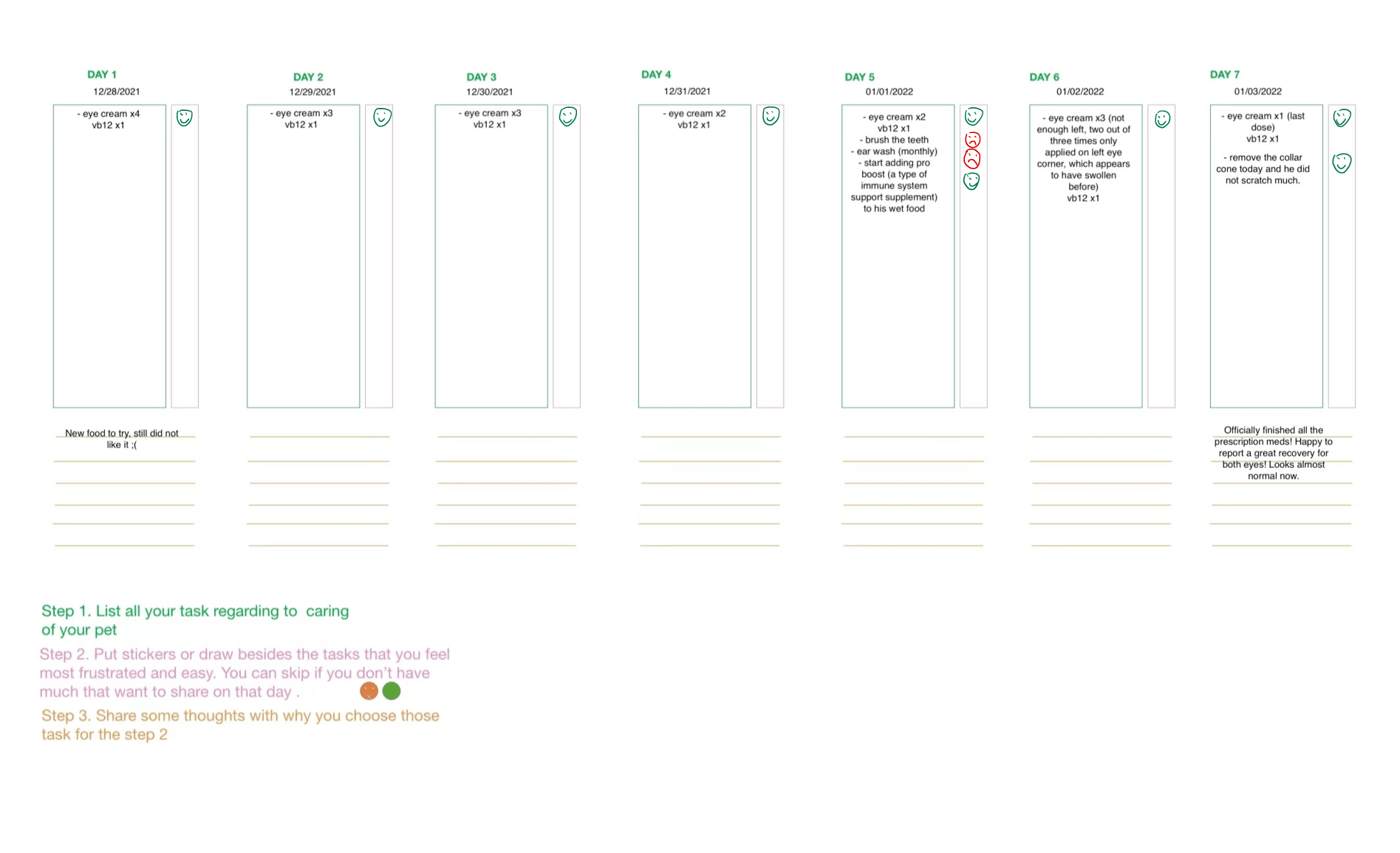
In the fourth week, in the first day, the cat developed a big scratch right under the right eye, which was treated using iodine antiseptic. At the end of fourth week, the scar from the eye fell out and the cat healed completely from the neuter surgery.
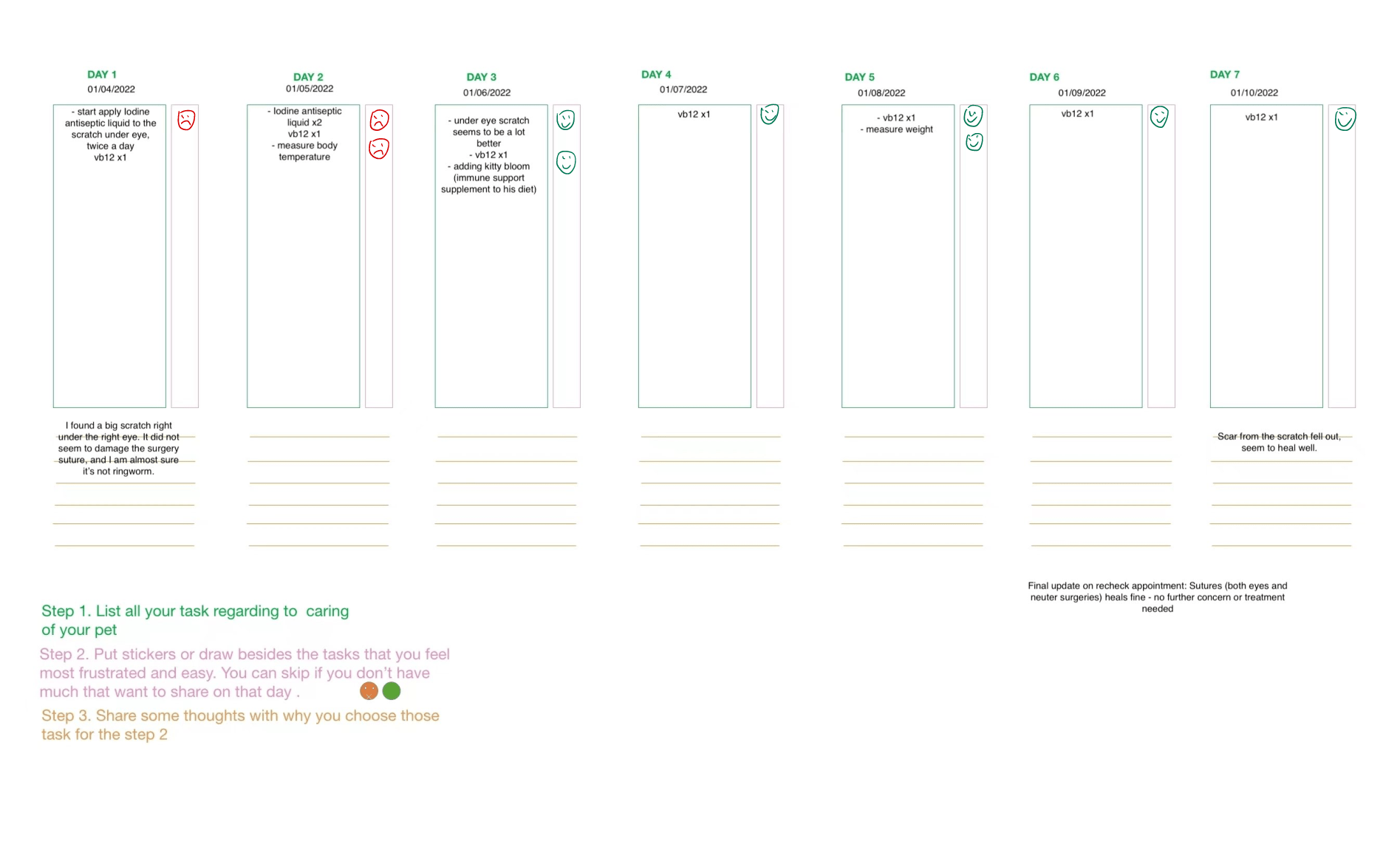
Analysis of Comparisons
The comparison analysis was done on eight design applications as shown in diagram below (see Fig. 16) based on various factors such as the function and planning feature. This feature includes the feeding suggestion, self-diagnosing of diseases and communication ways with the clinic veterinarian. The user flow and process, interface and layout, and finally a user review features are included in these products. Therefore, this product will aim at improving all these for the purposes of educating pet owners on the genetic related disease and how well they can take care of their purebred pets.
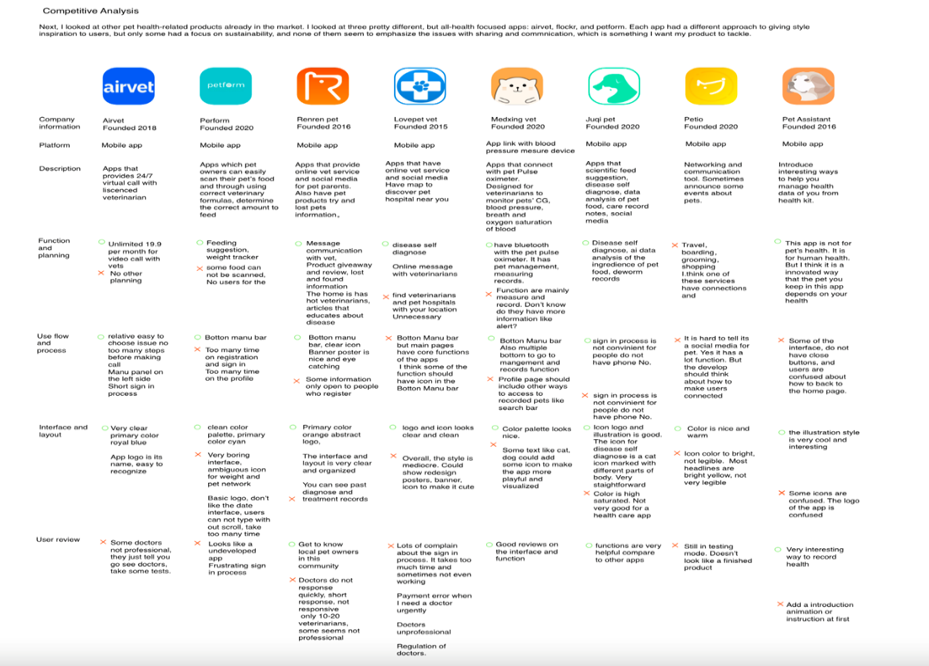
Ideation
After comparison analysis of various apps that provide pet health-related products in the market, brainstorming technique was employed. The result of the ideation technique was to ensure that the final product was to be end-user friendly. In this case, despite most apps focusing on inspiration to end-users, only a few of the web-designs focused on sustainability as shown in the diagram below (see Fig. 17). Therefore, the current UIUX Design will act to ensure sharing and communication of pet information and queries amongst the pet owners is implemented. This will be facilitated by an easy to navigate sign in process, easy to recognize interface and layout, with a very interesting method of recording health-related issues of the pets in the user review.
Persona
In this research, personas were created with their profiles containing information such as attributes, needs, pain points, needs and preferences. User needs include the reduction of the appointment check via online websites and the ability to access resources easily. The users also strive to maintain a healthy lifestyle for their pets. The users need to equip themselves with the knowledge to assess common symptoms while they are visiting the veterinary facility. In total, eight user’s personals are as described below.
Persona 1: Stephen B
- Demographic. Stephen B. is a male adult aged 26 years who loves both dogs and reptiles.
- Bio. Stephen has vast experience in taking care of dogs. The experience started when he was 10 years old and currently, he is managing a pet care business where he serves up to five households. During working time, he has managed to volunteer at a zoo where he handled lambs and goats. Moreover, he is an expert in delivering both oral and injectable medications. In this regard, he is experienced in self-care of animals who present with diverse health issues.
- Goals. Stephen’s goals are to find a pet clinic where he can share his stories and experience. Additionally, he wants a platform for vet, where pet owners can communicate, share, and connect with each other within a community.
- Motivations. He met his girlfriend and established that they both love animals. His preferences are composed of low cost and as simple as Instagram.
- Attributes. He owns his personal pet business and has been in the pet industry in the past couple of years. He is also a socialized person.
- Frustrations/Pinpoints. His pinpoints consist of high fees for pet clinics within the community that he serves couples with long waiting time for appointments.
- Preferences. Needs a simple design like Instagram with low cost.
- Preferred Channels. Facebook and Instagram.

Persona 2: Lucy. B
- Demographic. Lucy B. is a female adult aged 37 years who owns a 12-year-old mixed breed dog.
- Bio. Through adoption, Lucy. B owns a dog since the past four years from shelter within her community. Her dog, who is 12 years, is strong, healthy, and playful, but rarely goes for medication. Moreover, Lucy is a part-time dog sitter on rover, thus, during her leisure time, she helps other pet owners to care for their pets. In this case, Lucy is well knowledgeable of pet caring, and experienced in pet caring. Besides, she has a relatively strong attention to health of pets, despite not being a frequent visitor to pet clinics.
- Goals. Lucy wants an establishment of a social media account just for pets, pets parent community, and access to resources.
- Motivations. Her motivations are that her family loves pets, and her friends have pets at home. In addition, she has an Instagram account for her dog.
- Attributes. Apart from having a social media account in the form of Instagram for her dog, she is an experience dog sitter and cares a lot for the health of her pets.
- Preference. She has nice visuals and is easy to get hand on.
- Frustrations/Pinpoints. Her pinpoints consist of a lack of connection with other pet owners though social media accounts where their can share their experiences of pet ownership and care.
- Preferred Channels. Google meet, Facebook, Instagram, Reddit
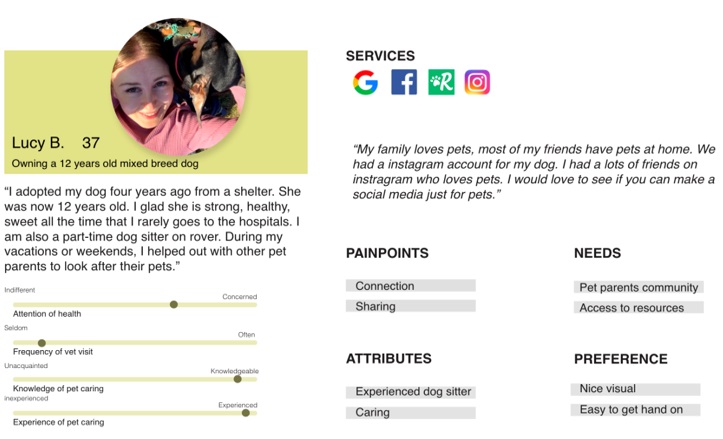
Persona 3: Megan and Jacob B.
- Demographics. Megan and Jacob are female and male adults respectively who own two cats and two dogs.
- Bio. They have owned the pets for the rest of their lives, until their senior dog was diagnosed with Urolithias, when they realized the importance of caring of pets after doctor’s treatments. During the time, they spent a lot of money in hospitals and in buying food and special health care products.
- Goals. Both Megan and Jacob require analysis symptoms for the pets and a able to track their routine care instead of severally visiting the pet clinic.
- Motivations. They are a family or couple that both love pets, and own multiple types of pets.
- Frustrations/Pinpoints. They lack sufficient knowledge for pet analysis systems, when to do deworming, bath, or brushing their teeth. They also have inadequate resources, hence would want to find resources that best suits their needs.
- Preference. A requires a simple design.
- Preferred Channel. Google, Facebook, Airvet, and Healthypaws.
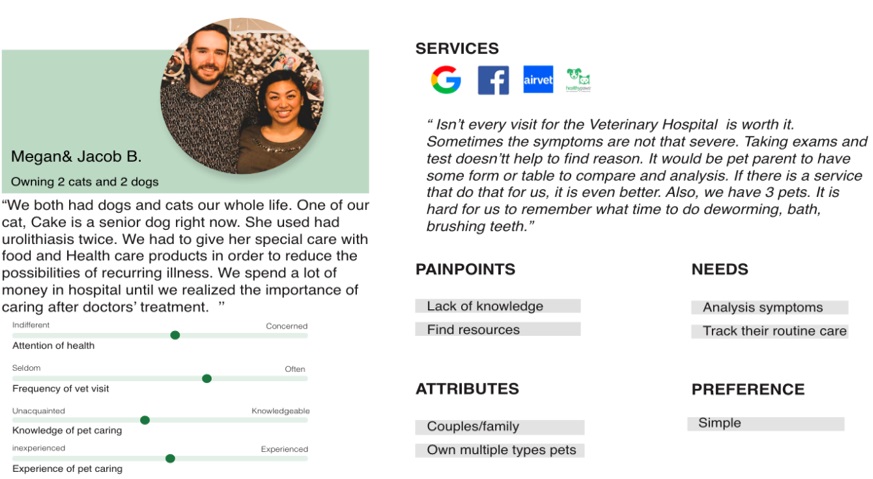
Persona 4: Gary, Yi
- Demographics. Gary is a male adult aged 26 years who owns a 6-month Purebreed Persian cat.
- Bio. His cat presents with symptoms of a sensitive stomach, diarrhea, and has been vomiting for every week since he adopted it. During his first moth of adoption, he spent more than a thousand dollar just for examinations and vet visit fees, in his four visits.
- Goals. His goal is to talk with pet owners and vets and have access to resources where he can be guaranteed communication and advice on severity of his pet illness and medication.
- Attributes/Pinpoints. His attributes consist of novice pet owner, nervous, and busy at work. Hence, he lacks the requisite knowledge of pets and would love to find pet resources.
- Motivations. He frequently visits vet clinics and is concerned about the attention of health of his cat despite having an average experience of pet caring with unacquainted knowledge of pet caring.
- Preference. Requires a simple design with easy interface that is clean looking.
- Preferred Channel. Google, Facebook, Airvet, and Instagram.
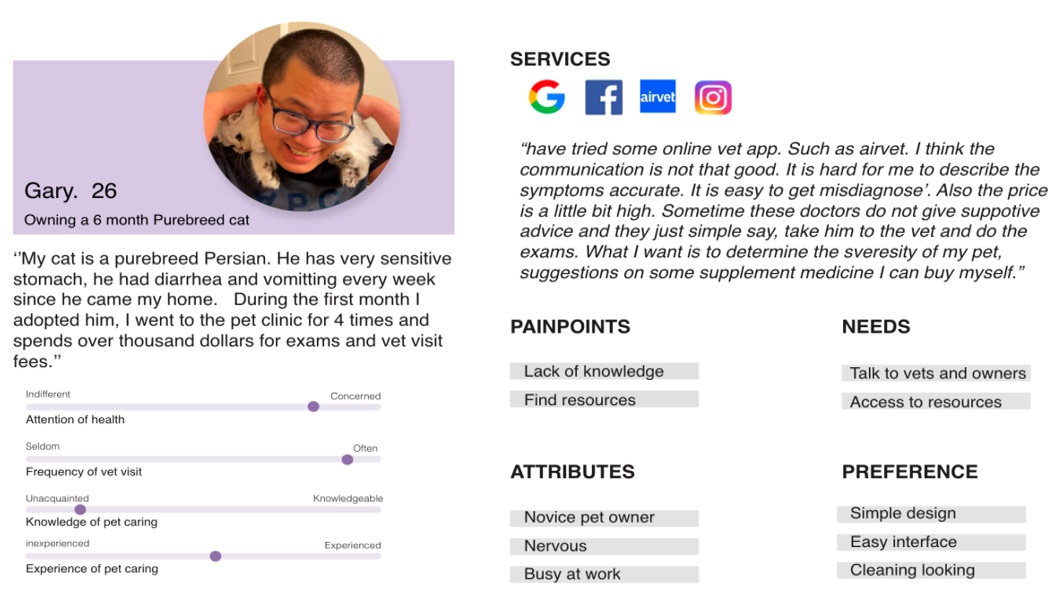
In summary, Stephen, who owns a dogs and reptiles works in a pet industry, Lucy, owning a senior dog is an experienced pet sitter, Megan, and Jacob, owning two dogs and two cats, are couple/family, and Yi Gary, is a novice purebred cat owner.
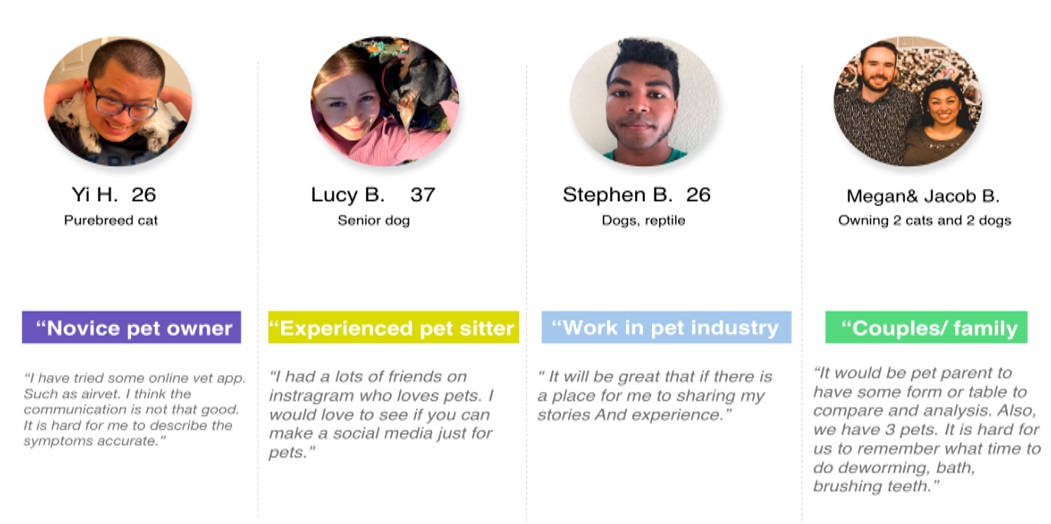

PetBook
This is an online-based persona web-based design, which was founded in 2009. It provides the community for pet owners to share their experiences and life issues as they care for the pets. The goal of Petbook is to create a better life experience for pet owners and pets. Under this design, members can share pictures of pets and communicate with each other through chats, comments, lick, bite, and setting up play days for the pets. The platform provides weekly updates on the current information about pets and how to connect with other pet owners. Therefore, through Petbook, multiple stakeholders benefit through the ease of information navigation and value exchange as indicated in the diagram below (see Fig. 24 below)
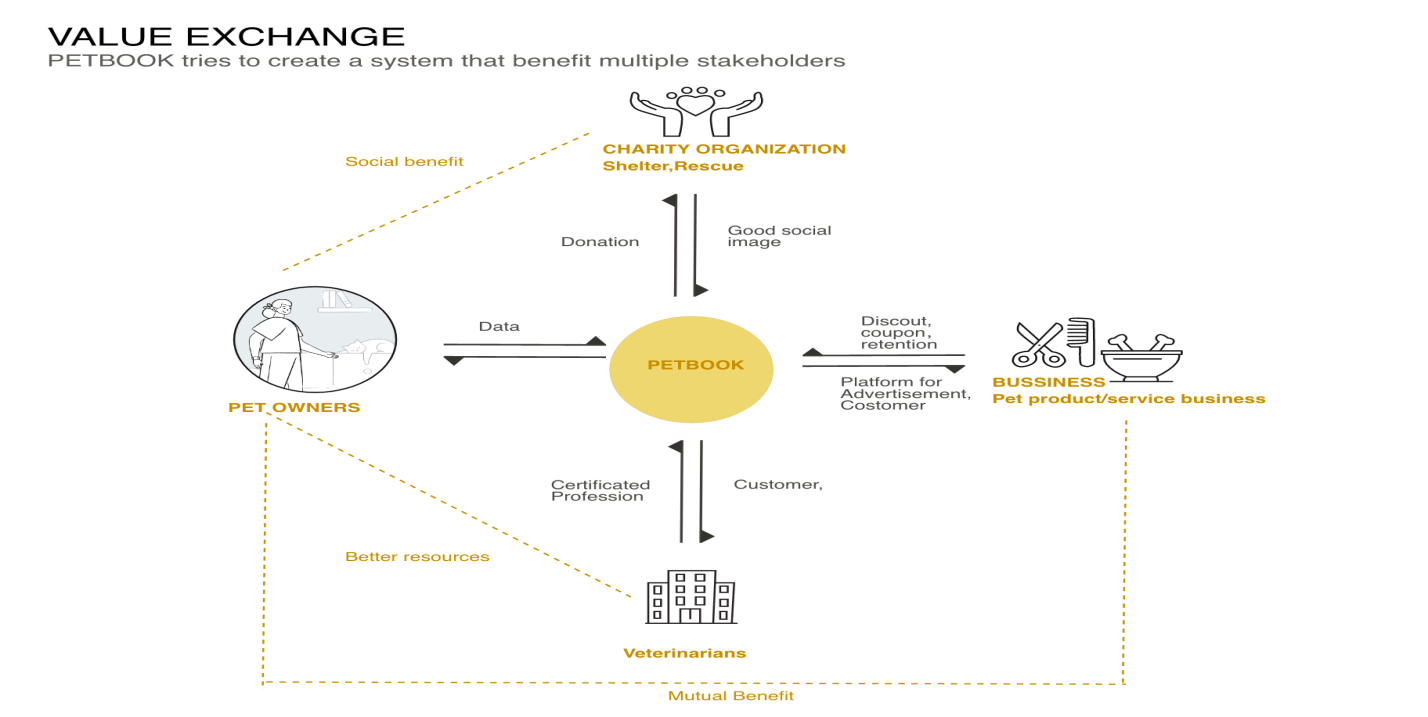
First Draft of the User Flow
The first draft of the User Flow for the UX/IU design portfolio comprised of five major interfaces/ main layers after the Log In and Walks Through interfaces. As indicated in Fig. 25 below, the first main layer is the Set Up Petbook. This can be done through a link on Facebook or a web-based design app. This layer contains Menu which has three more contents and information (the profile, support, and settings) of the design.
The second main layer interface is the Health Data and Calendar that when clicked, PetBook interface opens. Under this interface are the Deworm, Vaccination, Weight, Bath, Health Index. The role of these interfaces is to provide a calendar reminder for each category of the activities listed above. For instance, when one cannot tell when to deworm next their pets, a user will click on Deworm, and go ahead to set the calendar dates for next deworming.
The third section of the design in the main layer is the See Vet and Self-Care, whose main layer is the Health interface. In this case, a user has the capacity to self-diagnose or visit an online veterinary doctor just by clicking Health. Sharing and engaging is made easier by having a main layer known as Community. This comprises Discover and Pets Near You contents for uploading pets’ photos. It also entails Post, New Post, and Friends Posts, which are useful entities for sharing posts. Under the Community main layer is a GROUP/Forum layer that is vital for providing questioning and discussion of pets and pet’s issues.
Lastly, the Community interface contains Reward, Redeem/Discount, and Benefit. These contents are used in delivering rewards to those faithful users of the design; thus, will be used to drive traffic for the web-design portfolio. The last main layer is the Profile, which is used for setting up individual user’s profile during account opening. This layer comprises Add Pets, Profile Pic, Age-Sex, Background Pic, Location, and Setting as shown in the diagram below (see Fig. 25 below).

Final User Flow
Upon the verification, identification and understanding of the various persona’s needs and preferences, the final user flow is modified as indicated in diagram below (see Fig. 26). In this final user flow, the number of interfaces or main layers has been reduced to lower the amount of time needed for system navigation while using the design portfolio. Therefore, the final user flow comprises only four main layers, apart from the LOG IN and WALK THROUGH layers as compared to the draft that composed of five main layers. Once a user has logged in or walks though the design application, the first main layer found is the PETBOOK. Just as the draft, this layer contains the Deworm, Vaccination, Weight, Bath, and Health Index. They are used for creating calendar dates and reminders for each activity.

The second main layer is the HEALTH, which contains information regarding the health index and trends of each particular pet a user is interested with. The layer provides all the necessary health data concerning each pet under investigation of the user. The third layer is the COMMUNITY, which in this case, comprises the Discover and Pets Near You, used for uploading pets’ photos to the online pets’ community, an Article and Info interfaces for sharing and engaging with pets’ community. Moreover, the layer contains Group/Forum interface, which is used for providing questions or discussion on particular pets. Finally, the PROFILE layer has six main contents in the UI/UX design. They comprise: Add Pets, Profile Pic, Age-Sex, Background Pic, Location, and Setting as shown in the diagram below (see Fig. 25.)
Wireframe
A wireframe is a graphic depiction of a product’s structure that is currently being developed. Its purpose is to make it easier for designers to communicate the product’s structure (Plitman et al. 2). Wireframing is a process for visualizing the layout and functionality of a website while taking into account the needs and journey of the visitor. The description below indicates a page-by-page layout and guidelines on the UI/XU design portfolio.
The first layout of the wireframe based on the current design is as shown in the diagram below (see Fig. 10.). In this layout, there are two interfaces, LOG IN or CREATE A NEW ACCOUNT. A user, who opts to create a new account, is directed further to create account through Facebook, Google, or Apple.
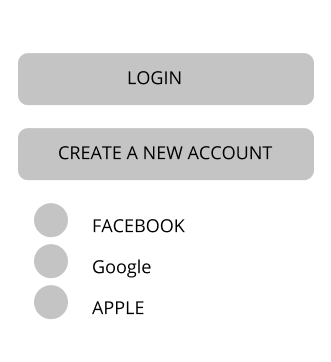
The second layout portrays of the wireframe takes the user to choose the type of pet they are visiting the application for. Once a user has identified the type of pet, they are to provide the pet’s name, breed type, birthday, gender, and chip identification. The user is also required to provide the weight of the pet in kilograms. The second layout generally is used a s pet’s identifier as shown in the diagram shown below (see Fig. 28.).

The third layout of the wireframe is Petbook with routine checks provided that consist of weight, food, water checks, and walk checks. A reminder can similarly be seen under this wireframe. For instance, in vaccination layer, a user can give remind dates like “next in 3 months.” This applies to other such layers as Dental, Deworm, and Medicine that requires calendar reminders. The third wireframe is illustrated in the diagram below (see Fig. 29). As shown in the diagram (see Fig. 30), the user can also add reminders to each activity for their pets so that they are reminded in the future in case they forget. In this case, an activity is clicked and a new interface with reminder is depicted. Alternatively, if an activity is not indicated from the shortlist, a custom reminder is used.
The wireframe also depicts hourly time frames for setting reminders from diverse pet’s care and activities. For instance, exact time, day, month, and year can be set using the wireframe shown in the diagram below (see Fig. 31), when such activities as shower taking, dental, ear cleaning, and skin are concerned.
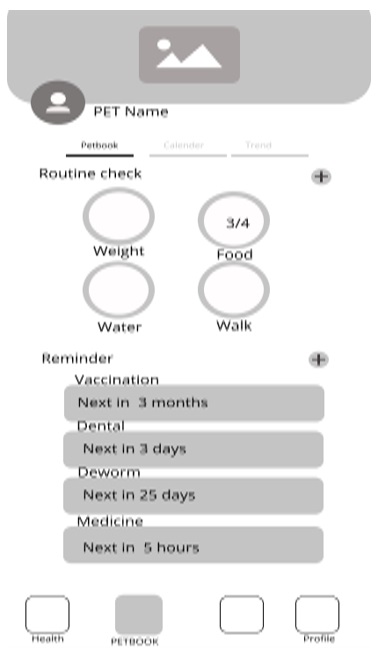
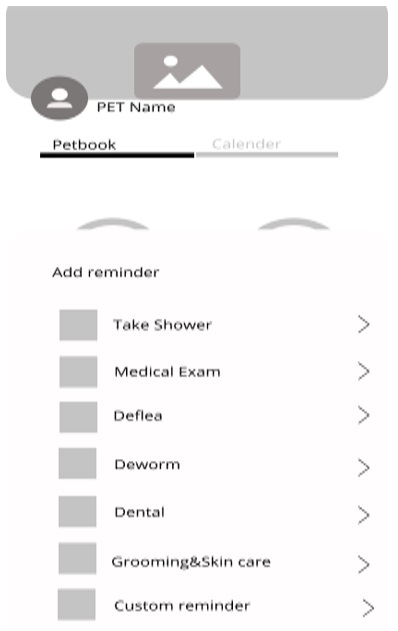

The sixth wireframe entails the COMMUNITY layer under the Discover content and information. In this case, a user can apply the navigation of this wireframe that depicts Pets Near You, to follow a pet that best interest them. Additionally, a user can choose from the various groups of Walking Party, CAT FIP Group, or Buy and Transfer to join. The Discover layer also contains articles that a user can read and find information related to the pets that best interest them. Below is a diagram indicating the Discover wireframe (see Fig. 32).

Lastly, under the COMMUNITY main layer, in the discover interface, additional icons of News and OFFERS are added. Similar to the previous wireframe as shown in Fig. 33, this wireframe contains more news about each particular pet and specific caption as indicated in Fig. 34 or as summarized in Fig. 35 below. It also contains offers where pet owners can view respective suggestions or proposals for their pets’ care and medication.
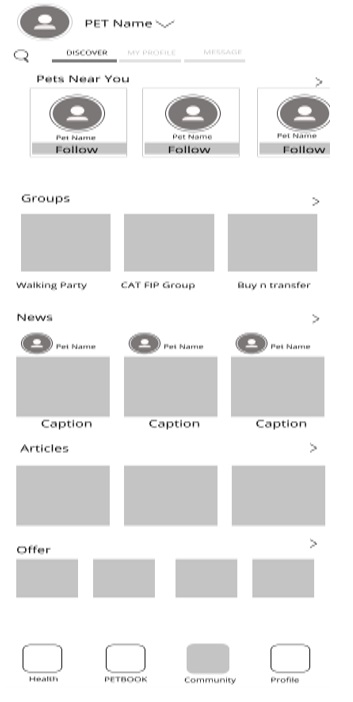
A summary of all the wireframes as used in the current design portfolio is as shown below. It summarizes all the six wireframes for ease of navigation through the application.

High Fidelity Prototype
This product aims to make it easier for pet owners to care to their pet. The product has an icon indicating “Pet book help you care for your pet.” The icon is displayed in the figure below.
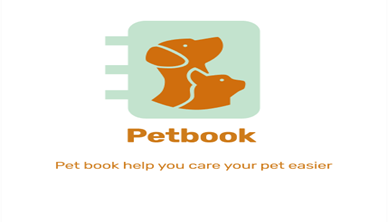
After clicking the icon, the user will be directed to a page indicating daily care and after surgery care easier. The product will help pet owners follow the care of their animals on a daily basis especially after surgery. The product will provide reminders and a notebook to record the routine care of their pets.

The next page will indicate a place where the user can find friends in the community with a breed similar. This will help community members share ideas on caring for the pets especially if they are experiencing similar health issues.

This part informs the user that the resources required to treat and care for their pets are found here. It includes the diagnosis records of pets that have suffered from various health issues.
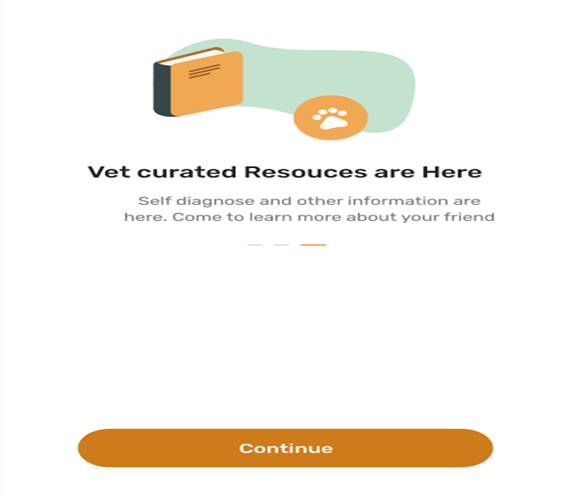
This part is login page. The user will register using an email or through their facebook account. However, those who have already created accounts before will click the sign in button and login into the product using their credentials.

The users with an account will be directed to this page. They will enter their credentials and click on the login button. However, if they have forgotten their password, they can recover it by clicking the “forgot password” area.
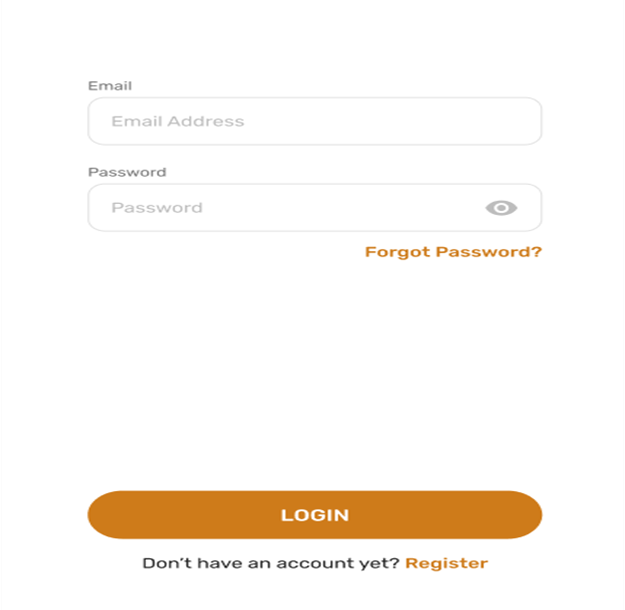
When creating an account, the user will add their name in the area indicated “Your Full Name.” They will then add their email and their private password. Before creating account, they will read the terms and conditions and the private policy. After that, they will indicate they agree to the terms and conditions.
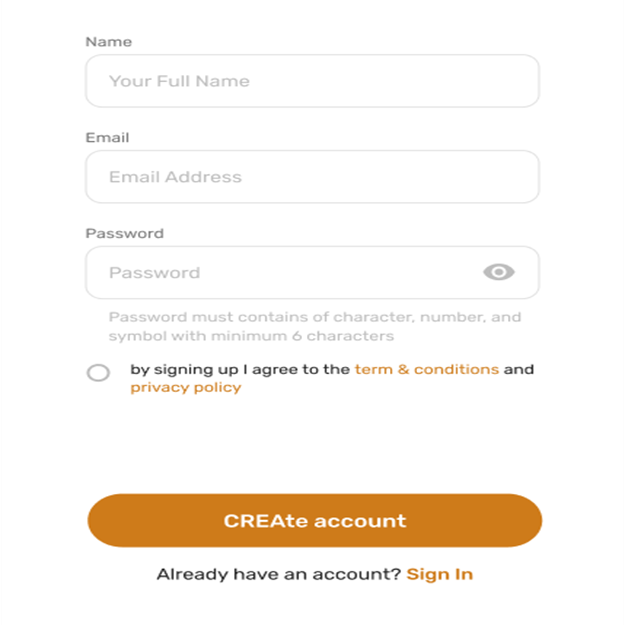
In this part, the user will enter their email address and submit to receive a link to reset their password.
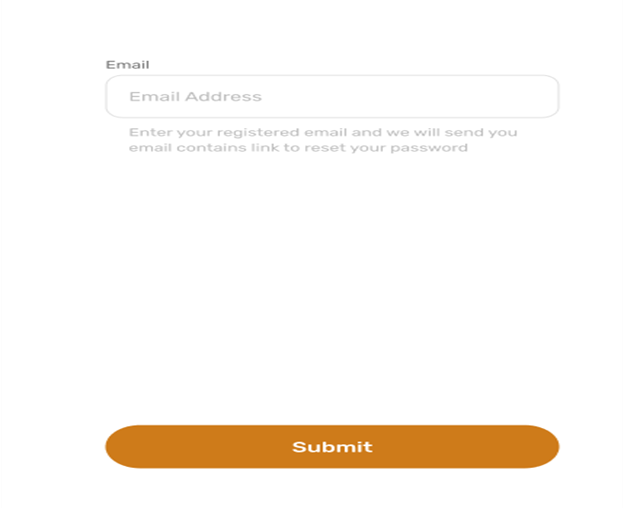
This shows an example of a pet profile. It indicates the age, gender, and the weight of the pet.
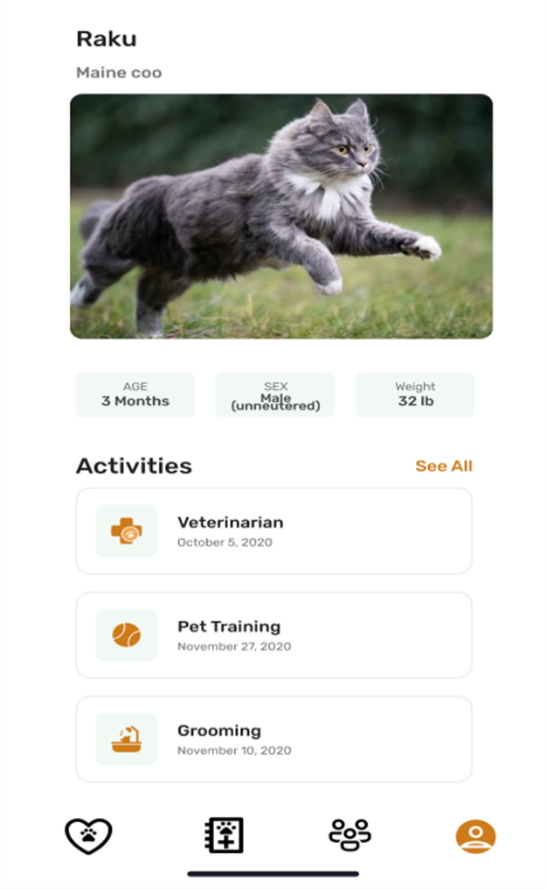
Here, the user enters the details of the pet. It includes the pet’s name, the type of the pet, the breed type, birthdate, gender, and the weight of the pet. There is also an area to give a short a description about the pet. Lastly, after filling in all the details, the user clicks the “save” button to save the work.
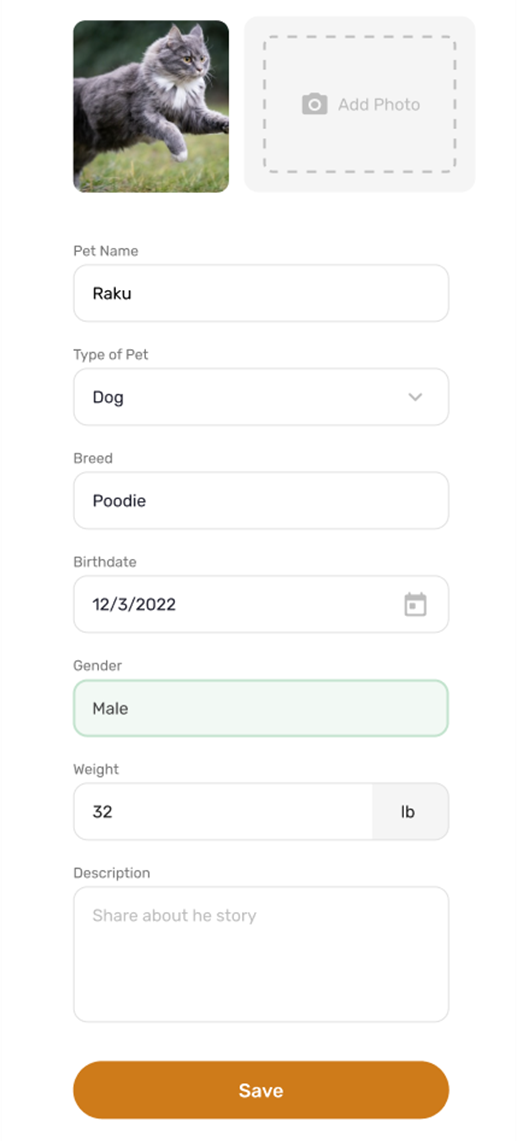
This section entails the birthday and the weight of the pet. There is scale to adjust the weight of pet before clicking the save button.
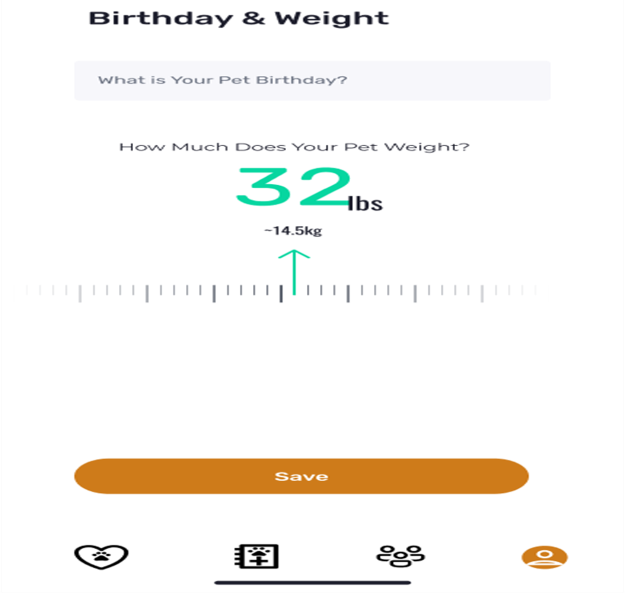
In this part, the user enters the pet’s name and creates an avatar for the pet.

In this part, it entails the selection of the type of pet.
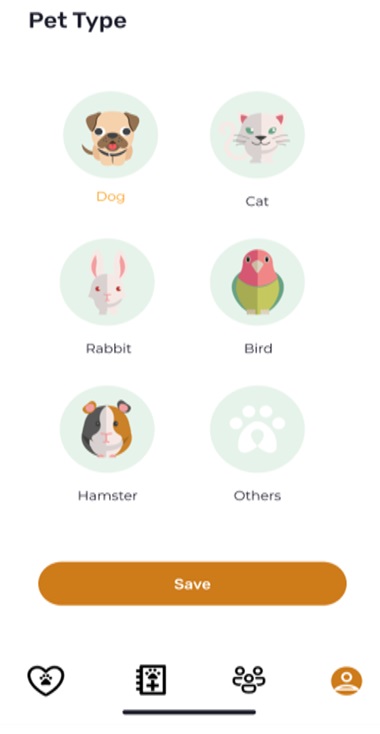
This section allows the user to identify other pets near them. There is an option to follow them and read through their routine care.

This section displays the resources available in this product. It shows the section for nutrition, health care and training. The user will select what they intend to do.
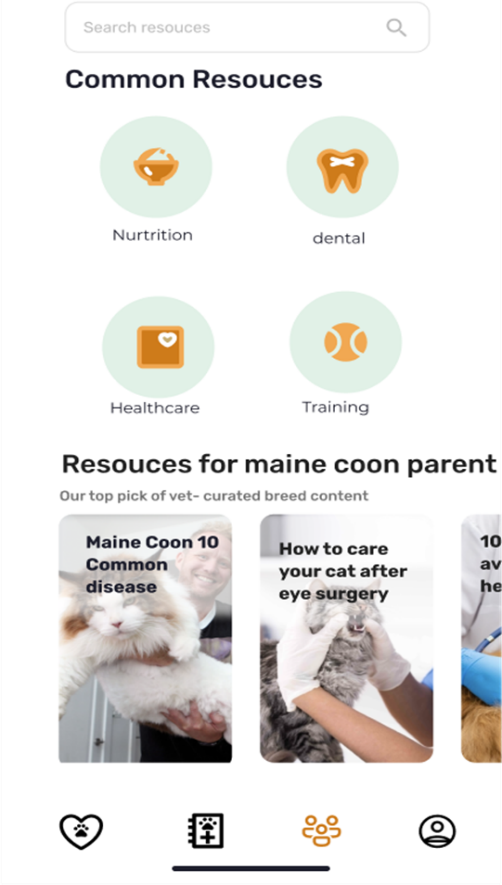
This section entails the routine book of the pet. It also indicates a reminder area showing upcoming activities such as vaccination of the pet.
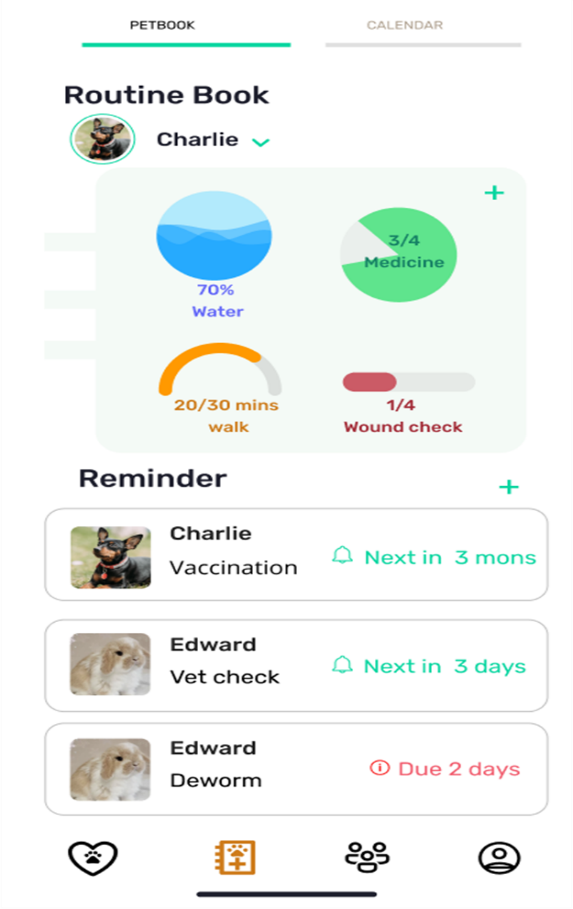
This is a calendar section to mark the date a certain activity took place.
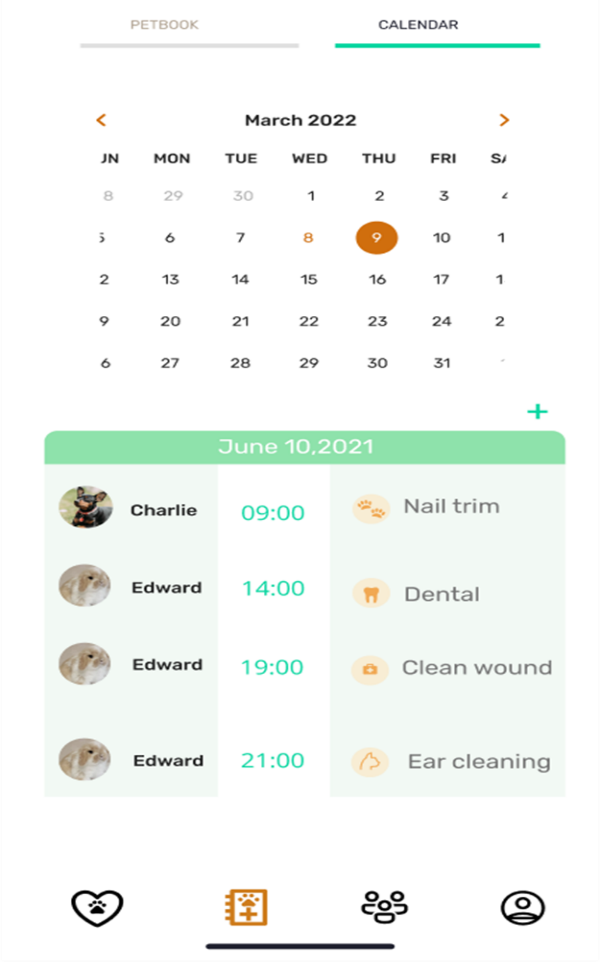
The above section records the steps made by the pet on a daily basis.
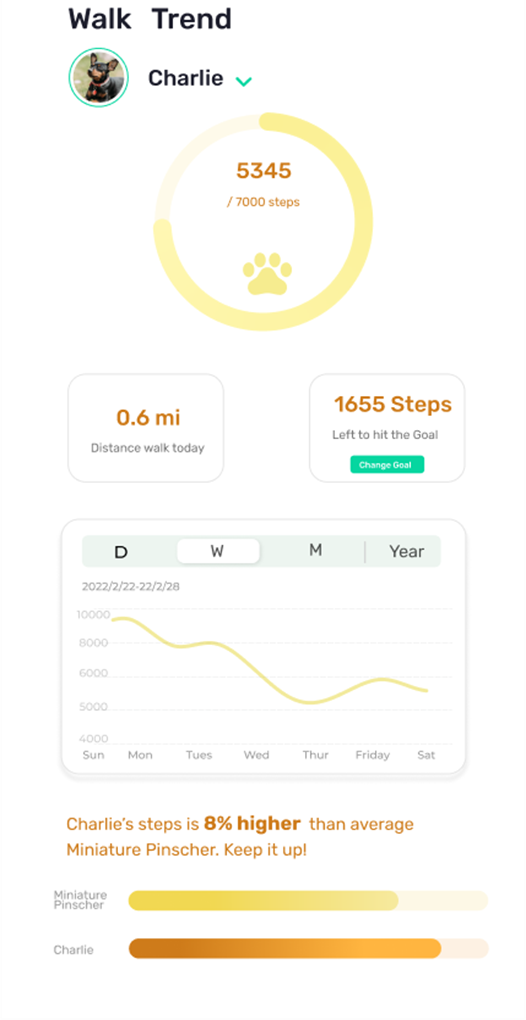
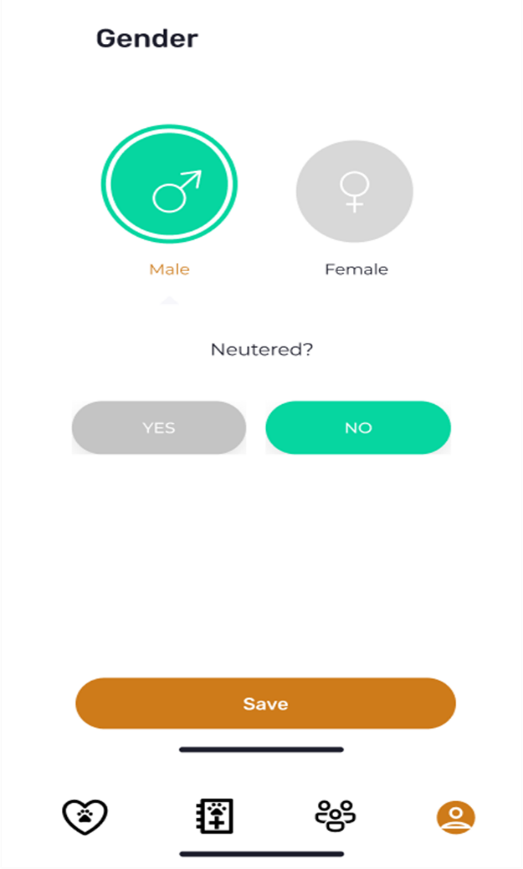
This section comprises of gender selection of the pet.
This section analyzes the health of the pet. It displays the heart rate, temperature, and the weight of the pet. It shows when there is a change in the condition of the pet.

This section indicates the tasks the user wants to undertake. On clicking the desired task, the user gets further instructions on how to carry out the routine.
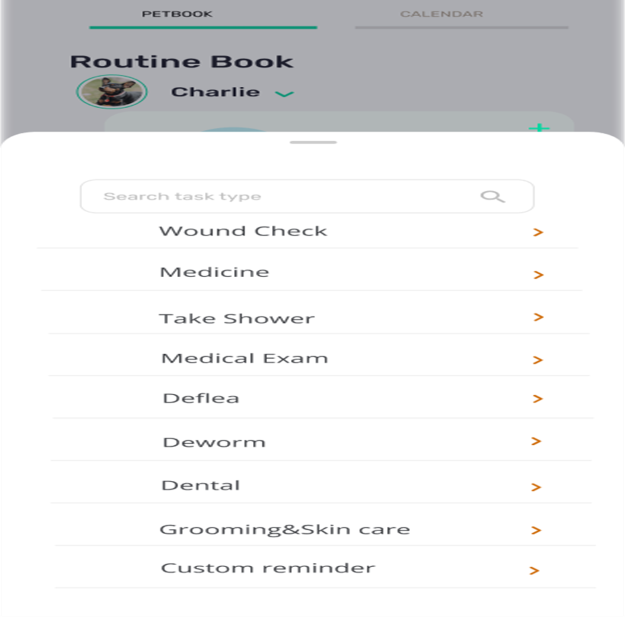
The figure below shows the steps to follow when creating an account or signing in into the product. It is also a summary of all the steps following in describing the prototype.
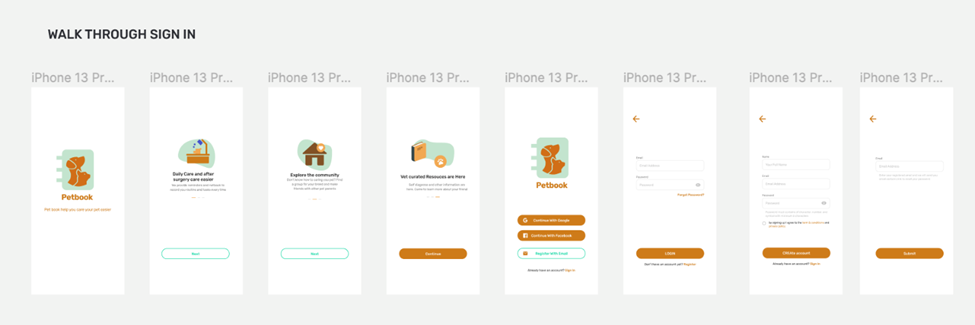
Testing and Results
Conclusion and Future Work
In conclusion, this product will help pet owner’s better care for their pets. This is because it has features that guide them through routines, which are required by their pets. In terms of health, the product monitors the pets’ condition to ensure they are healthy and well-fed. They will be able to stay up to date on future events involving purebred pets thanks to the reminder feature.
From the above, I was able to deduce some future work for the betterment of this app.
For future work, designers should be able to engage the users. For instance, the app needs to have a friendly interface with an influence of various colors in the app design. People would love an attractive app, so these hues will have communicative power and inspiration on the user. This will also help to differentiate one page from the other. Future work should similarly contain review option. In this case, I would include a review section where a user is reminded to review or rate their experience using the app. This will enable the designer to address challenges that the user might have encountered and put in place measures to facilitate easy use. Lastly, there should be an addition of a pop-up notification feature just after logging in to give urgent messages or issues. For instance, in the case of a disease outbreak or a call for vaccination, a user is notified before navigating through the app. Moreover, an integration of a welcoming message, for example, ‘Welcome to Pet Book’ after a successful log in is necessary to solidify a user’s first impression should be considered in future designer’s work.
Work Cited
Plitman, Liran, et al. “Motivation of Owners to Purchase Pedigree Cats, With Specific Focus on the Acquisition of Brachycephalic Cats.” Animals, vol. 9, no. 7, 2019, pp. 1-18.